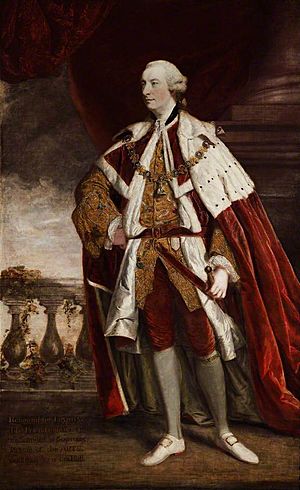Hugh Percy, 1st Duke of Northumberland facts for kids
Quick facts for kids
The Duke of Northumberland
|
|
|---|---|

Portrait by Joshua Reynolds
|
|
| Personal details | |
| Born |
Hugh Smithson
c. 1714 Newby Wiske |
| Died | 6 June 1786 (aged 71–72) |
| Resting place | Northumberland Vault, Westminster Abbey |
| Nationality | British |
| Spouse | Lady Elizabeth Seymour |
| Children | by Lady Elizabeth Seymour: Hugh Percy, 2nd Duke of Northumberland Algernon Percy, 1st Earl of Beverley Lady Elizabeth Anne Frances Percy by Elizabeth Hungerford Keate: James Smithson |
| Parents | Langdale Smithson Philadelphia Reveley |
Hugh Percy, 1st Duke of Northumberland (born around 1714, died 6 June 1786) was an important English nobleman and politician. He was also a large landowner. He is known for his building projects and for supporting artists.
Contents
Early Life and Family Name
Hugh Smithson was born around 1714. His parents were Lansdale Smithson and Philadelphia Revely. In 1733, he inherited the title of Baronet from his grandfather, Sir Hugh Smithson.
In 1740, Hugh married Lady Elizabeth Seymour. She was a very important heiress. Her family, the Percy family, owned a lot of land in England. They had held the title of Earl of Northumberland for many centuries.
In 1749, Hugh changed his family name to Percy. This was done through a special law passed by Parliament. This change connected him more closely to his wife's famous family.
Becoming a Duke
When Elizabeth's father, the 7th Duke of Somerset, died in 1750, Hugh received a new title. He became the 1st Earl of Northumberland. This was a special arrangement because of his wife's family line.
Later, in 1766, Hugh was given an even higher title. He became the 1st Duke of Northumberland. This made him one of the most important noblemen in England. He also became a Knight of the Order of the Garter in 1756. This is a very old and respected order of knights. In 1762, he became a Privy Counsellor. This meant he advised the King.
Political Roles
Hugh Percy was active in politics. He was a supporter of King George III. He held several important government jobs.
From 1763 to 1765, he was the Lord Lieutenant of Ireland. This role meant he was the King's chief representative in Ireland. Later, from 1778 to 1780, he was the Master of the Horse. This position was in charge of the King's horses and royal stables.
Supporting Arts and Building Projects
The Duke of Northumberland was a big supporter of art and architecture. He helped many artists and builders.
He was a major patron of Canaletto, a famous painter. Hugh bought several of Canaletto's large paintings. He also had Canaletto paint scenes of Westminster Bridge, a new bridge being built in London.
Hugh was also a commissioner for building Westminster Bridge. This means he helped oversee its construction. He rebuilt his own home, Stanwick Park, around 1739–1740. He even designed parts of it himself. He also built an observatory at Longhoughton. This building was designed by the famous architect Robert Adam.
The Duke and Duchess were important patrons of Robert Adam. Adam designed beautiful neoclassical interiors for their London home, Northumberland House. This grand house was later taken down around 1870. Some parts of its famous Glass Drawing-Room are now in the Victoria and Albert Museum.
Adam also designed many interiors for Syon House, another of their homes. These designs were made in the 1760s. At Alnwick Castle, the Duke hired James Wyatt for work. The Duke also had Brizlee Tower designed for him.
Homes and Estates
The Duke of Northumberland owned many large estates and grand homes. These included:
- Alnwick Castle, in Northumberland
- Syon House, in Middlesex
- Northumberland House, in London
- Stanwick Hall, in Yorkshire, which was the original home of the Smithson family
- Kielder Castle, in the Kielder Forest, Northumberland. This was a hunting lodge built in 1775.
Death and Family
Hugh Percy died in 1786. He was buried in the Northumberland Vault inside Westminster Abbey.
He and his wife, Elizabeth, had three children:
- Hugh Percy, 2nd Duke of Northumberland (1742–1817)
- Algernon Percy, 1st Earl of Beverley (1750–1830)
- Lady Elizabeth Anne Frances Percy (died 1761), who was also buried in Westminster Abbey.
Hugh also had another son, James Smithson, with Elizabeth Hungerford Keate Macie. James Smithson became a famous chemist and mineralogist. He is known for leaving money to create the Smithsonian Institution in Washington, D.C..
Images for kids


